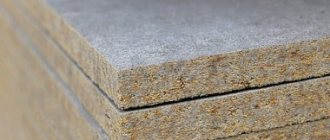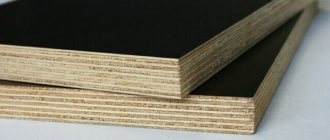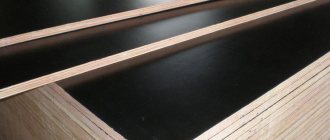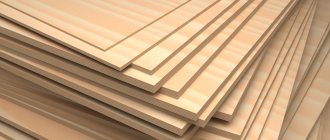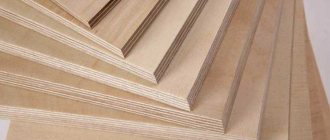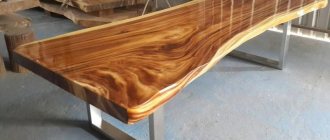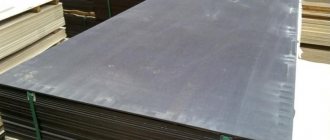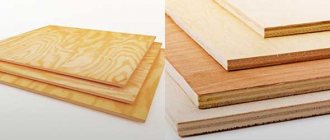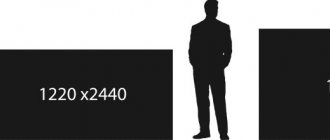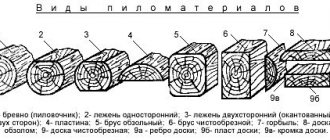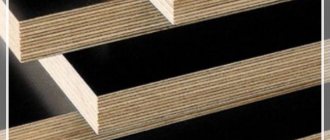A material such as plywood is wood-based and quite difficult to manufacture. It is made from veneer sheets that are glued together. For the production of plywood, raw materials are used, for the preparation of which a machine such as a peeling machine is used. On it, sheets of veneer are cut from round logs, which are also called “churak”.
The veneers used to create plywood sheets come in different lengths. In general, their length can vary from 1.3 to 3 meters. As for the thickness of the prepared veneer sheets, it all depends on the type of plywood. Thickness can vary from 0.3 to 4 millimeters. Be that as it may, it’s worth talking in more detail about the types of plywood.
Structure and main difference
Any plywood consists of layers of natural veneer, firmly glued together. The only difference is the wood that is used to produce the veneer, the method of arranging thin layers and the composition for gluing or impregnation. The dimensions of the sheets do not depend on these parameters and can be the same for different types.
In FK type plywood, the veneer layers are glued together using urea-formaldehyde glue. In FSF materials, gluing is carried out using phenol-formaldehyde glue resins. This is the fundamental difference between the types of FC and FSF, from which corresponding consequences follow.
The external difference between FC and FSF is manifested in the color of the layer. The ends of FC plywood are lighter, while FSF has a noticeable reddish dark tint. This is explained by the fact that urea-based glue becomes transparent when hardened, while formaldehyde resins are colored.
The difference between FSF and FC is as follows:
- adhesive composition;
- moisture resistance;
- strength;
- end color;
- price;
- content of hazardous substances.
And all this depends mostly on the glue. The urea composition is soluble in water, so FC plywood products are afraid of getting wet. FSF, unlike FC, is a moisture-resistant material.
Note! The difference in cost is noticeable. With the same size and grade (quality), the price of FSF is usually higher than FC.
Of course, the cost will be affected by the location of production, additional processing and some other factors. But the general trend can still be traced.
It should be noted that there is also another type of plywood - FOF. She belongs to the special forces group. The difference between FOF and FSF plywood is that the former is covered with a durable laminated film. Thus, its moisture-resistant properties increase even more.
How is plywood marked?
The photo shows the plywood markings.
FC plywood marking includes 4 main types:
- FC;
- FSF;
- FB;
- FOF.
The letters used allow you to determine the resistance to moisture.
The resistance of the adhesive joint to direct moisture directly depends on the type of glue used:
- FC - average level of water resistance.
- FSF - increased level of water resistance. The layers are bonded using phenol-formaldehyde resins. It is a universal option, used for external and internal work. The specific features of this species are resistant to external factors.
- FOF (laminated) is covered with a special film coating. It is considered indispensable when carrying out external work: formwork structures, monolithic construction.
Plywood is also classified depending on the type of wood used:
- birch (hardwood veneer);
- softwood (softwood veneer);
- combined.
Plywood sizes
As a rule, manufacturers adhere to standard sheet sizes.
Typical sizes:
- 1220x2440 mm;
- 1525x3050 mm;
- 1525x1525 mm;
- 1220x1525 mm.
In rare cases, the dimensions of FC plywood can be 1 by 1 by 1 by 2, 2 by 2. The thickness of the sheets ranges from 4 mm to 30 mm. They produce aircraft plywood, the thickness of which is minimal - 2-3 mm.
Variety of plywood FK - FKM
Photo of FKM plywood.
FKM plywood is produced using melamine-formaldehyde and melamine resins. Melamine is a crystalline, colorless substance that is practically insoluble in water. It is obtained from formaldehyde.
Compared to phenol-formaldehyde resins, melamine resins practically do not decompose at room temperature. Thanks to this quality, they are especially in demand for the production of all kinds of products intended for household use (except for kitchen utensils).
Features of FKM plywood:
- high level of moisture resistance;
- safety and environmental friendliness ensured by the absence of phenolic compounds; thanks to this quality, plywood is recommended for the production of all kinds of furniture and interior finishing work.
Application of FC
FC plywood sheets are made from hardwood, mainly birch, poplar, and alder. This is a wonderful material, the highest grades of which are distinguished by a light, smooth surface.
The peculiarity of FC is that, due to the adhesive, it does not withstand prolonged exposure to moisture and, when wet, swells and delaminates. At the same time, if such plywood is used in a dry room, it exhibits high strength characteristics.
FC plywood is used to make beds, sofas, and boxes for transporting goods; they cover walls with it, and place it on the floor under parquet or laminate. Like other species, its thickness varies, reaching a maximum of 40 mm. The varieties depend on the presence of knots, sprouts, cracks, darkening and other defects.
The question may arise: should FSF or FC plywood be used for flooring, for example, under parquet? These two types are suitable, although moisture-resistant FSF plywood products (low grade, sanded and unsanded) are preferable. The difference between them will also be in price. If the room is not damp, it is not a ground floor, not a basement, then in order to save money, you can use FC. Most often, when laying floors, sheets with a thickness of 10-12 mm are used.
Varieties and labeling
FSF plywood is made from soft or hard trees; they can be either deciduous or coniferous. It can be longitudinal or transverse, have 3, 5 or more layers (three, five and multi-layer, respectively). These gradations can be combined by manufacturers in various proportions.
Building materials can have different grades:
- Grade I is characterized by the greatest damage - the total length of defects on 1 sheet should not exceed 20 cm;
- Grade II - the length of the cracks is up to 15 cm, the presence of an adhesive composition on the surface of the products is permissible (no more than 2% of the area of the plank);
- Grade III – holes from knots, falling knots, and wormholes are acceptable for it;
- Grade IV implies the presence of various manufacturing defects (an unlimited number of wormholes with a diameter of up to 4 cm, fused and unfused knots), such products are considered the lowest quality.
They are characterized by minimal deviations in the structure of the wood. Wormholes, knots and holes from them, veins and other defects are not allowed.
To determine the main parameters of plywood boards, manufacturers attach markings to the building material. Let's give an example: “pine plywood FSF 2/2 E2 Sh2 1500x3000 x 10 GOST 3916.2-96”. The marking says that the presented plywood sheet is made of pine veneer using FSF technology, with front and back surfaces of grade 2, class 2 phenolic emission, double-sided sanding, thickness 10 mm and dimensions 1500x3000 mm, manufactured in accordance with GOST 3916.2-96 standards.
Application of FSF
FSF plywood is considered a moisture-resistant material and more expensive. Its production uses both birch and coniferous veneer.
It can be used outside buildings, in places with high humidity. Thick FSF sheets are durable and wear-resistant. They can be impregnated with fire retardants, as a result of which the plywood receives fire-resistant properties. This type is designated FSF-TV. It is used in passenger railway carriages, often laminated with decorative film.
FSF sheets are used as roofing material for the construction of stages, sports fields, temporary structures, and billboards. Such plywood is widely used for formwork, and the best option here is laminated material, since it can be used several times (up to 100).
Although furniture for residential premises is not made from FSF, it is excellent for garden benches, gazebos and other structures. Another common application is truck floors and van linings. It is allowed to make boxes for transporting non-food products from FSF sheets.
What types are there
There are quite a few types of modern plywood, but the most popular is the moisture-resistant version. And before you visit an online store selling moisture-resistant plywood, you still need to understand all the features of all the types that exist.
In total there are the following types of material:
- For general purpose.
- For construction work.
- For the production of furniture.
- Decorative.
- Bakelite.
- Laminated.
The first type is a material glued together from wood veneer sheets. It is made from coniferous timber. As for construction plywood, it is used in construction work as a structural material and to create formwork. Naturally, such material is of high quality, and it contains phenol-formaldehyde resins.
As for furniture plywood, it has excellent external qualities. It is also distinguished by its ability to withstand significant loads. When considering the decorative appearance, it is worth noting that it is additionally lined with film materials that are made on the basis of synthetic resins. A similar material is used in the construction of ships and the creation of furniture elements.
Bakelite plywood is made from veneer that is impregnated with phenol-formaldehyde resins. During the process, the material is subjected to significant pressure and a large amount of adhesive is used. The finished material has an increased level of strength and excellent density.
When considering laminated plywood, it should be noted that it is able to withstand any negative environmental influences. Therefore, it is used to create wear-resistant surfaces. It is often used to create reusable formwork, since the material can be washed and even treated with cleaning agents.
Most of the listed species are able to withstand moisture, so to one degree or another they are all moisture resistant. In view of this, it is worth talking in more detail about what advantages moisture-resistant plywood still has.
Advantages of the material and its disadvantages
The production method makes plywood durable and resistant to deformation. This is achieved through the presence of several layers and special adhesive compositions. Therefore, the following advantages of such plates can be highlighted:
- Moisture resistant. Waterproof plywood is not subject to destruction when exposed to moisture. It does not peel off into layers and is not deformed.
- Easy to use. The high strength of the material does not interfere with the processing process. Plywood is easy to process using a variety of tools. It is easy to install.
- Compatibility with other building materials. Most often, waterproof plywood is used as an additional material. It easily combines with natural and polymer building materials.
- Wear resistance. Plywood can withstand mechanical stress without compromising its integrity.
- Resistant to temperature changes.
- Wide scope of use.
- Aesthetics. Plywood has an original wood pattern and color in appearance.
- Affordable price. Plywood boards are cheaper than solid wood. And you can always save money by choosing a lower grade material.
The only drawback of the material is the presence of harmful substances included in the glue. We are talking about formaldehyde. Therefore, it is not recommended to use plywood in residential areas and where there are children or people with allergies.
